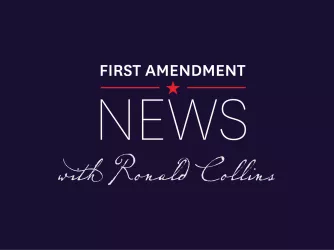Table of Contents
Canaries in the coal mine: Kaufmann Report warns of ‘Academic Freedom in Crisis’

Canaries are considered a sentinel species because they can detect carbon monoxide and other poisonous gases before humans can. Beginning in 1911, coal miners started using canaries to detect dangerous levels of such gases. If a canary in the coal mine fell ill or died it provided a warning to the coal miners that they were in danger and that it was time to evacuate. Although canaries are no longer deployed in this way, the analogy of the “canary in the coal mine” remains useful.
In regards to academic freedom, a number of “canaries” over the past decade suggest that, in the United States, its current state is precarious. Although this view has its critics, a new report by Eric Kaufmann of the Center for the Study of Partisanship and Ideology in the United Kingdom suggests we may have reached a tipping point in deciding whether we are still dealing with some “canaries in the coal mine” or if we have reached the point where there is now ample evidence that faculty should be concerned about the state of academic freedom in the United States (as well as Britain and Canada).
A Decade (or More) of Canaries in the Coal Mine
Although it no longer seems plausible to argue that academia does not skew to the left politically, the view that this skew is a problem for the academy remains controversial. Some argue that the leftward tilt of the academy is primarily the result of self-selection, with liberals more likely to pursue a career in academia than conservatives. A career in academia may, for a number of reasons, be more attractive to people who are on the political left, just like other fields (e.g., business, policing) are more attractive to people who are on the political right. Others argue that, in addition to self-selection, conservative scholars are more likely to face political discrimination in subtle and direct ways, and that this climate of hostility not only contributes to the leftward tilt but also poses a threat to the research process and academic freedom.
Over the past decade, an impressive number of “canaries” have emerged from the coal mine to suggest that the increasingly leftward tilt of academia is problematic. These “canaries” include findings demonstrating that a notable portion of faculty is willing to politically discriminate against each other professionally; that increased education levels are positively correlated with ideological prejudice; and that political tolerance is decreasing among the most educated people in younger generations. In the past six months, a number of faculty have expressed concerns about threats to their academic freedom.
The Iceberg Model of Discrimination
No-platforming attempts of speakers and faculty for their political views or scholarship, successful disinvitations of speakers, actual shoutdowns of speakers, and suspension or termination of faculty as a result of some form of expression or expected expression can all be considered harsh forms of political discrimination. Other harsh forms of discrimination include threats of disciplinary action from administrators or colleagues. Yet, as some have pointed out, these kinds of events have a “denominator problem”: There are over 4,000 colleges and universities in the United States and this number always far exceeds whatever the numerator is for such events in any given year. In response to this, Kaufmann suggests using an iceberg metaphor when thinking about how political discrimination can threaten academic freedom.
In the iceberg metaphor, harsh forms of political discrimination represent the tip, or “canaries in the coal mine.” Subtler forms of political dsicrimination represent most of the iceberg’s mass, beneath the surface of what is easily observable. These subtle forms of political disrcimination include finding it harder to be hired or promoted, facing harsher peer-review of articles or grant proposals, experiencing discomfort expressing one’s ideas or views among colleagues, and the self-censorship of one’s views or ideas because of the feared social consequences.

Is Political Discrimination Really a Problem for Faculty?
When it came to harsher forms of political discrimination, notable portions of centrist or conservative faculty report being threatened with disciplinary action for their speech. In regards to hiring, political discrimination was evident among faculty on the left, in the center, and on the right. Fourteen percent of faculty on the left said they would discriminate against a conservative job candidate, compared to 8% of centrists and 2% of faculty on the right. In contrast, 17% of faculty on the right and 16% of centrists stated that they would discriminate against a job candidate on the left, while just 7% of faculty on the left indicated that they would do this.
The story is similar for peer-reviewing a paper or grant proposal and making decisions about promotion. A small minority of faculty admitted they would explicitly engage in political discrimination against their ideological opponents. For instance, among faculty on the left, 13% said they would discriminate against a faculty member on the right during a promotion decision, 14% said they would discriminate during the peer-review process, and 24% said they would do so if reviewing a grant proposal. The percentages were similar for faculty on the right when asked about their colleagues on the left (16%, 14%, 16% respectively).
It is important to keep in mind, however, that although a quick glance at the percentages for harsher forms of discrimination suggest that centrists and faculty on the right are slightly more likely to discriminate in hiring and equally likely to discriminate in peer-review and promotion decisions than faculty on the left, the base rates among faculty members skews heavily to the left when it comes to their politics. Thus, there are far more faculty members who are on the left on most campuses. Even if centrist and more conservative faculty members are more willing to engage in political discrimination, a conclusion that is not warranted given much of the scholarship — including the findings of the Kaufmann report, there simply aren’t that many of them on most campuses compared to their more left-leaning counterparts.
Faculty were also surveyed on their support for dismissal of colleagues who have reached controversial conclusions in their research in regards to topics such as the impact of ethnic diversity on a community, the effects of the British empire on the world, whether children do better when brought up by two biological parents, and the impact of greater diversity on organizational performance. Depending on the research topic anywhere from 7% to 18% of social science faculty indicated support for a campaign to dismiss such a professor. In every single one of the examples cited above, support for political discrimination against other academics was more pronounced in the social sciences and humaniteis than in the STEM disciplines.
When it comes to subtle forms of political discrimination, 50% of centrist or conservative faculty report they have experienced psychological pressure because of their beliefs, and also that they are uncomfortable expressing their beliefs to colleagues. A majority of conservative faculty (70%) reported a hostile climate for their beliefs in their academic department, compared to 36% of centrists, and 4% of faculty on the left (5% for very left, 3% for fairly left). Self-censorship is particularly acute in the social sciences and humanities, with 70% of conservatives and 42% of centrists reporting that they have refrained from airing their views in the classroom and in their research.
It is clear that a significant portion of conservative and centrist faculty think that many of their colleagues harbor hostility towards their views and ideas. However, it is possible that these conservative and centrist faculty have misjudged their colleagues — for instance, as noted above, only a small minority of faculty members support the firing of colleagues. The use of a list experiment in a number of the surveys helps to dispel this notion. A list experiment is designed to reduce the impact of social desirability bias on responses to survey items. One half of a sample is presented with a list of three items and are asked how many of the items they agree with or how many of the items make them angry. The other half of the sample is presented with the same list of items and an additional one. The additional item in these surveys asked faculty about political discrimination.
The results of the list experiment revealed that 40% of faculty in the United States would discriminate against a faculty member who was a Trump supporter; this percentage is almost twice as high as the percentage of faculty who explicitly admitted they would engage in political discrimination. Perhaps even more troubling is the finding that a portion of current Ph.D. students do not even conceal the fact that they would openly engage in political discrimination — 33% openly admit they would engage in political discrimination and this figure only increases to 35% when using a list experiment.

Key Takeaways from the Kaufmann Report
These findings are encouraging, as they all coalesce to suggest that a small minority of faculty are willing to explicitly discriminate against colleagues with different political views, and that this discrimination is more likely to occur in fields more likely to grapple with politicized topics (i.e., the social sciences and the humanities). It is, however, concerning that the opposition to hypothetical campaigns to sanction or terminate colleagues for reaching conclusions that are politically unpalatable for the majority of academics was not particularly strong, with only roughly half of academics opposing most such attempts.
Notably, in the case of a colleague who reported data showing greater gender and racial diversity negatively impacts organizational performance, only 31% opposed such a campaign. Indeed, a good number of faculty remain “unsure” or “neutral” on this issue, and conceivably could be moved to support or oppose such campaigns. Kaufmann makes note of this:
Most academics and PhD students in the United States, Canada, and Britain don’t actively oppose academic freedom, but they don’t actively support it either. Most are unlikely to speak up for colleagues who dissent from social justice inspired restrictions on their academic freedom.
Thus, although only a small minority of academics support ousting those with controversial views or research interests, explicit support for academic freedom among academics themselves is tepid. Furthermore, younger professors and current graduate students were more likely to identify as left or far left compared to their older counterparts and are among the academics most sympathetic to using political discrimination against colleagues. In other words, there is cause for concern. As more tolerant and less ideologically extreme faculty retire, they are likely to be replaced by faculty who are more ideologically homogeneous, less tolerant of political disagreement, and more supportive of attempts to sanction or terminate their colleagues.
So, according to the Kaufmann report, political discrimination is a problem for faculty and it appears it is a growing problem. Like all research, there are valid criticisms that can be made of Kaufmann’s approach. However, it is hard to ignore the consistency of the results across seven different samples of faculty members obtained in three different countries. We have moved past the stage where the “canaries” can provide us with advance warning of threats to academic freedom and have reached a stage where we now have ample evidence that academic freedom is under threat. FIRE will continue to remain vigilant and, when necessary, defend against these threats.
Recent Articles
FIRE’s award-winning Newsdesk covers the free speech news you need to stay informed.

As compliance deadline looms, colleges must resist censorship — and the feds must provide more clarity

This town fought residents over political yard signs — now it’s paying the price

Alex Kozinski on JD Vance’s censorship speech — First Amendment News 459
